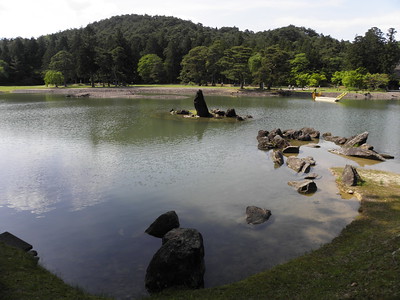Hiraizumi

Hiraizumi –Temples, Gardens, Archaeological Sites Representing the Buddhist Pure Land comprises the ensemble of four gardens and a sacred mountain that is seen as a unique and influential example of planning and garden design.
Hiraizumi blossomed as a rival to Kyoto as the political and administrative centre of northern Japan in the early 12th century. These monuments were built by the ruling clan during this short-lived period. They mix indigenous Japanese concepts of nature worship with the ideals of Pure Land Buddhism, a branch of Mahayana Buddhism.
Community Perspective: “a mix of Kyoto temples in the location of Nikko, in a region with a lack of significant cultural sites compared to other parts of Japan”. Motsuji is deemed the highlight among the inscribed locations.

Map of Hiraizumi
Community Reviews
Lithobates

Visit date(s): October 5 & 6, 2024
Nearby sites on trip: Hiraizumi (extension)
Overnight location: Onsen near Ichinoseki
Location(s):
- Môtsû-ji
- Kanjizaiô-in Ato (photo)
- Chûson-ji
- Mount Kinkeisan
- Hiraizumi Cultural Heritage Center, on Mount Kinkeisan (There is one other site listed, but the staff at the cultural centre suggested that it wasn’t worth the trip because there wasn’t really access for visitors. Some artefacts were in the centre. There were photos of some others that are in the Tokyo national museum.)
Travel method(s): car and foot
Travel duration: Less than 15 minutes
Visit duration: 1 day total
OUV: This is difficult to fully evaluate without belonging to or studying the culture of Japanese Buddhism and Shintoism. The reconstructed gardens were certainly lovely, tranquil and meditative places. The preservation of the 12th century Konjikidô is amazing where so many wooden structures have been lost to fire.
Best of: The heavily gilded temple Konjikidô of Chûson-ji was absolutely stunning. Inside the concrete sheath, every detail has been preserved. A recording gives information about the features alternating in English and Japanese, so we could study it, then pay attention briefly before viewing some more. The gardens, though less showy, were very relaxing.
Worst of: We have no pictures of Konjikidô. Photos are not permitted. Shuffling past it was the only crowded part of the visit.
J_neveryes

Under light snow in February 2023, I explored Chūson-ji Temple site of Hiraizumi. My introduction to the temple area was by walking through Tsukimizaka (Moon Viewing Slope), lined by well-postured cryptomeria trees. The slope leads to a slightly meandering path, which is decorated on both sides by subordinates temples and shrines.
All but three buildings at the site are reconstructions. The three surviving originals buildings are:
- the gold-leaf covered Konjiki-dō (built 1124 but restored in the 20th century);
- Konjiki-dō Ôidô (built in 15th century), which sheltered Konjiki-dō before the current concrete building; and
- Chūson-ji Kyôzô (built in 1122 with the lower storey reconstructed in the 14th century).
While one may visit the grounds for free, you must pay to visit Konjiki-dō and the museum. While Konjiki-dō is objectively a visually stunning structure, its aura is compromised by how this small building is presented. To elaborate, the allure of experiencing a building in situ is severely reduced when the said building is kept inside a concrete structure and behind glass. Looking at Konjiki-dō in this setting aroused the same emotion in me that I get when I look at an interesting artifact under a glass display in a museum. A mild, dispassionate interest.
Nan

The first Japanese gardens I saw on my visit to Japan was in Hiraizumi. It takes a while to fully appreciate the artistry of a Japanese garden, so initially I felt somewhat underwhelmed. The gardens are small in scope and at first note seem random.
It was only after I had seen more of the gardens all across Japan (Kanazawa, Kyoto) that I was able to grasp that most of what I was seeing was not random nature, but planned and arranged to look natural. Back home I looked at the pictures and those from Hiraizumi stood out.
The site is spread across the city. There is one trail where there is a bear warning. The temples are fine examples and I felt that Hiraizumi was a good start on my Japan trip.
Getting There
Hiraizumi is a bit off the average travellers itinerary for Japan. But equipped with a Japan Railpass and relying on the excellent Japanese high speed rail network it's easily feasible as a relaxed day trip from Tokyo (Ueno). In Hiraizumi itself you can do everything on foot.
On Japanese Gardens
While Hiraizumi is a great garden, the best garden I have seen was in Kanazawa (Kenrokuen). I really hope the Japanese will submit it eventually. Apparently, Japanse list the following three as the best landscape gardens:
Els Slots

I started my visit to Hiraizumi with a smile on my face after the friendly welcome at Hiraizumi railway station: the seats are heated at the public toilets, there are coin lockers to get rid of any unnecessary luggage and there is the tourist information which hands out all kinds of folders and maps in English. I needed it after having been on a crowded train from Tokyo sandwiched between a fat older man and a sleeping salaryman.
And then I headed off into town – a very prosperous-looking town that is, just as Frederik noticed below. It’s about a 10-minute walk to the first of the 5 inscribed locations: Motsuji Temple. This is mainly known for its garden, a large landscape garden centered around a lake. I was blessed by great weather, which added to the fine composition. I also loved the building with the thatched roof at Motsu-ji.
I had read in the AB evaluation that “visual links between sites are compromised”. It sounded like overreacting to me to lament about electricity poles, but I was annoyed also when one of those kept showing up in my photos of Kanjizaiô-in Ato. This is a smaller pond, close to Motsu temple. After visiting the world heritage center, which has some interesting displays, I climbed up to Mount Kinkei. This “sacred mountain” fortunately isn’t even 100m high. There’s not a lot to see, which is also the case at Muryôkô-in Ato: an archeological field on the other side of the railway tracks.
After having visited 4 out of the 5 inscribed parts, I took a taxi to bring me to Ryokan Shizukatei for the night. This fine traditional Japanese hotel lies some 8 km out of town, amidst the rice fields. I received a heartily welcome and was pampered from that moment on with great food and a Japanese bath.
The next morning, the ryokan owner dropped me at Chuson-ji. This is the main temple complex, and I thought I had saved the best for last. It consists of many wooden temples and other buildings. The thing to see here is the Golden Hall. This unfortunately is encased in a protective building. After paying the 800 Yen (8 EUR) entrance fee, I felt that I entered a museum. It is also not allowed to take photos of it. It’s a brilliant piece of work however, imagine how it would be if it still stood outside among the trees and the other temples. In general, though, Chuson-ji did not live up to my expectations and I rate Motsu-ji with its great garden as the best sight in Hiraizumi.
Frederik Dawson

Located in the Tohoku or Northern Japan that severely suffered from earthquake and tsunami in 2011, Hiraizumi was selected as a World Heritage Site, since then the government used the inscription as the symbol of hope of this region. From Matsushima, a beautiful bay near Sendai which was hit by tsunami, I took a train to Hiraizumi. After kept my luggage in the coin-storage, I walked from the very lovely train station to Motsu-ji Temple. The town itself looked very clean and new, hard to believe its status as historic town, I thought this was the result of World Heritage Site beautification process. After short nice walked I was at Kanjizaio-in, the temple ruin was actually a large lawn with some trees and bushes around a pond, a fine place but nothing remarkable.
Motsuji Temple was my next destination, as I visited in March, this ancient garden turned to be the ice rink! However, the garden was lovely and photogenic with stones and pebbles around the pond similar to many Zen gardens in Kyoto, the most important part of the garden was the standing rock, if you saw some old photograph, you may notice that the rock had been changed its position! Then I took the bus to Chusonji Temple, the bus system of Hiraizumi was really well designed for tourists, there was a loop line called Run Run Line (pronounce like “ruin ruin” and be careful there is another bus line called Ran Ran Line that connect Hiraizumi with nearby town of Ichinoseki and pronounce like “run run”) and the bus connected all World Heritage Sites together, and with Day Pass at 400 Yen could save a lot of money and time.
As Chusonji was located on the high hill, the entrance pathway was surprisingly steep thru the pine forest. Along the way, there were many old wooden shrines and buildings which were quite lovely but nothing unique compared to other similar hilltop temples in Japan. The main attraction was the Golden Hall of Konjikido which located behind the glass wall, was quite small than I anticipated, but it was pretty amazing to see such brilliant gold building with many lovely details and looking it was quite spiritual enlightenment. After Konjikido, I saw its old storage building and a museum which kept many artifacts, one of most remarkable was the Buddhist Bible written in silver and gold. By the small down hill road next to the museum, I went to see the ruins of the paradise garden; the garden was quite similar to Kanjizaio-in, however much smaller. Muryokô-in, this site again similar to the other was an empty space with some stones and very shallow ponds.
After visited all those sites, the best site I saw was Motsuji since it reminded me the garden of Byodoin in Uji which was another World Heritage Site and was constructed in the same period and by the same Fujiwara Clan. For Konjikido Golden Hall, it cannot be considered unique as Japan has another golden building, the famous Kinkakuji, also in East Asia, there are many golden halls which are bigger than Konjikido, but as I mentioned, it was truly amazing piece of art and should be seen. In my opinion Hiraizumi was quite a mix of Kyoto temples in the location of Nikko. All in all Hiraizumi was a fine place, in the region which quite lack of significant cultural sites compared to other parts of Japan, Hiraizumi could be a nice place to visit. I recommended combining Hiraizumi trip with Matsushima and Yamadera which was considered top three cultural sites in this region.
Community Rating
- : Mihai Dascalu
- : Milan Jirasek
- : GeorgeIng61 Vincent Cheung Cutecid Errol Neo Xiong Wei Chenboada Joe Kuri Luke LOU Tcchang0825 Alex Goh
- : Els Slots Zoë Sheng Xiquinho Silva Dhhtravel Lithobates Ssong.x
- : Nan Svein Elias Shandos Cleaver Petteri Randi Thomsen AC
- : J_neveryes Frederik Dawson
- : Clem C Nafis N
- : Caspar Dechmann
- : Sncjob
Site Info
Site History
2011 Inscribed
2008 Deferred
Site Links
Unesco Website
Official Website
Related
Connections
The site has 20 connections
Art and Architecture
Constructions
Human Activity
Individual People
Religion and Belief
Timeline
Trivia
Visiting conditions
WHS Names
World Heritage Process
Visitors
77 Community Members have visited.
The Plaque
No plaque has been identified yet for this site.